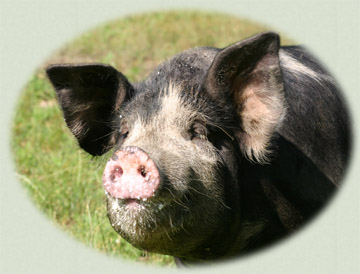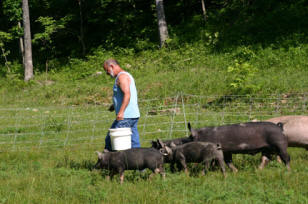
Once upon a time, pork was America’s favorite meat. From Colonial times until the 1950s, pork was the mainstay of the American diet, outselling both beef and chicken decade after decade. From the 1950s through the 70s, pork consumption decreased steadily and the diet craze that began in the 1980s sent the industry into a tailspin. As chicken became America’s favorite meat, pork producers responded by promoting pork as “the other white meat” and switched from raising tender, tasty farmstead hogs to producing pork with as much as 30% less fat. The reduction in fat cut a few calories, but it robbed the pork of intramuscular marbling ~ where the flavor and juiciness reside. The end result was pork that was tasteless and dry. Not the best incentive to buy a package of pork chops or a pork roast for Sunday dinner.
Fortunately for those of us who long for the taste of old-fashioned, homegrown pork, one group of producers held fast and maintained the original, delectable taste of pork: the producers of Berkshire pork. Research has shown that Berkshire pork not only has finer marbling but also shorter muscle fibers (translates into more tender meat). A University of Iowa taste test Berkshire pork ranked first in 22 out of 24 traits that influence tenderness, meaning the Berkshire is genetically predisposed to producing the finest quality pork.
Up to now, the major market for Berkshire pork was not the US but Japan, where taste took priority over fat content. In Japan Berkshire pork is called Kurobuta (Black Hog) and is prized as much as Kobe beef, but now, chefs at upscale restaurants in the United States have “discovered” Berkshire pork and it is an centerpiece item on their menus. |
|
"It's a great, versatile product," said Tom Boyce, chef de cuisine at Spago, in Beverly Hills in California. "... It's definitely one of our favorite things to cook out here. It's God's favorite animal as far as I'm concerned."
The French Laundry in Yountville, California, has gone to great lengths to get purebred Berkshire pork, says chef Corey Lee. “It's a very specific taste," he said. "It doesn't have the generic mild taste of most market pork." And Michael Kaplan, chef at Strata in New York says Berkshire pork “has a natural juiciness to it that you can’t compare to any other pork.”
Although the Berkshire’s genetic predisposition for flavor is important, the genetics of the Berkshire breed is only 1/3 of the equation for superior tasting pork. Another third is related to the food the pig eats while he is fattening. Swine are unusual in that the fat they eat is not broken down by the digestive process but deposited into the muscle intact. Pigs are, quite literally, what they eat. Feed a pig peanuts and the pork will end up with a peanut flavor. Give them pecans or apples and the meat will have a slightly nutty or fruity flavor. This amazing ability to capture the flavor of the foods they eat is why a top New York restaurant recently paid $1000 per animal for peanut, acorn, and alfalfa raised hogs. (FYI, confinement raised hogs average $160 each).
|
Here on Greenwood Farms, we are pleased to announce that we are now raising Berkshire pork. We raise our hogs on clover pasture (ever hear of the phrase, “happy as a pig in clover?”) and a mixture of corn and oats. This is all good nutrition, but what makes our pork special is that we supplement their diet with our own whole Jersey milk, giving the pork a flavor that hints of cream. As a health bonus, the CLAs and Omega 3s from the milk of the pastured Jerseys are deposited in the fat of the pork, making our Beyond Organic Pork as healthy as it is flavorful.
The third part of the “flavor equation” in great-tasting pork is a low-stress lifestyle. Stress causes all animals to produce energy at the expense of the intramuscular fat, resulting in dry, tough meat. For pigs, heat is a major stress factor. Pigs have no sweat glands and must “wallow” in the summer to keep from overheating. We go beyond simply giving our pigs a wallow. Our Berkshires live in a pasture with a spring-fed pond on one side and a cave that maintains a temperature of 60 degrees year-round on the other. This keeps our pigs happy and cool in even the hottest weather.
Raising quality pork is an art and a science. We do our best to keep our pigs happy and comfortable during their time with us. and in return, the pigs reward us with pork that tastes better than any we’ve eaten. Please see our price list to view the cuts of pork we currently have available.

